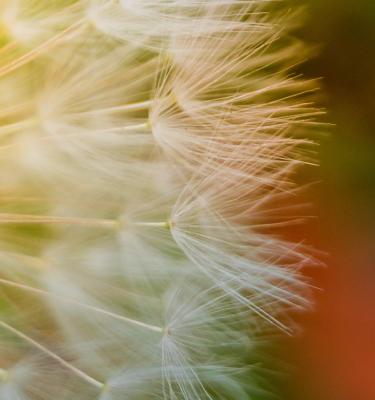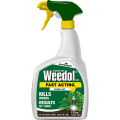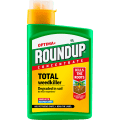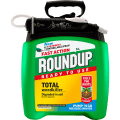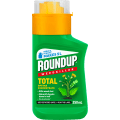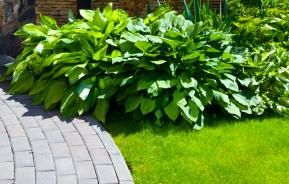In order to understand how weedkillers work, we first need to understand what a weed is. There are many types of weed and the type you have will determine the weedkiller you choose to get rid of them.
What is a weed?
The dictionary says that a weed is ‘A wild (not deliberately cultivated) plant growing where it is not wanted.’ By this definition, virtually any plant that’s growing where we don’t want it to grow is a weed.
But it’s those unwanted plants that invade and threaten to take over your paths, patios, flower beds, borders and lawns that are the real problem. If you need any help identifying plants that are commonly thought of as weeds, we have recently written an article showing the characteristics for identifying weeds.
What are weedkillers?
Weeds can be very frustrating and extremely difficult to remove, especially without them reappearing. With traditional methods of weed removal proving to be very arduous work in some circumstances there needed to be a more effective alternative.
Weedkillers are chemical-based liquids that are specifically engineered to target different types of weed in the best way possible. Whatever the weeding job that you are trying to tackle, there is a weedkiller that is matched to that job and will do exactly what you need.
When to use weedkillers
Weeds can generally be killed at any time of the year. But the best time to use weedkillers is when they are growing strongly (usually in the Spring and Autumn) because they absorb weedkiller more quickly. This is particularly the case with Systemic and Selective weedkillers which rely on activity within the plant for their effectiveness. Apply liquid weedkillers in calm conditions to minimise the drift of the solution onto wanted plants. Application to the leaves results in weedkiller moving up to the growing points and down to the root tips.
Location of the weed is also important. For example, if a weed is growing in the middle of the lawn then you should use a selective weedkiller, and if it is growing between patios or pavings then a residual weedkiller would be more appropriate.
In situations when you are looking to clear a patch of land and plant up quickly it is possible to use a glyphosate-based weedkiller which would allow you place new plants after only 24 hours without causing the new plants any harm.
How to use weedkillers
Using weedkillers is often simple providing you read and follow the detailed instructions that are clearly printed on every weedkiller pack. Unless you are using a hand sprayer or a Pull & Spray pack, you will need to:
Use a watering can
With a fine rose or a weedkiller sprinkle bar that will give you effective control over where you apply the weedkiller. Remember a separate watering can is advisable if accidental damage to other plants during normal watering is to be avoided.
Use a pressure sprayer
These are amazing for treating large areas. Always read the label to find out which application method (watering can or sprayer) is suitable for the product you want to use. Do not walk across treated areas until dry, to avoid the transfer of products onto desired plants.
Weed by hand
Grasp the weed as close to the ground as possible and steadily pull it out (roots and all). This is fine for the odd one or two weeds, but back-breaking if the weeds are rampant. It is ineffective with deep-rooted or spreading weeds. Find out more about hand weeding.
Dig or forking out weeds
Even more strenuous than hand weeding and care must be taken to remove every bit of the offending plant and roots without damaging the plants to be kept. Any bits of perennial weed roots left in the ground will grow into new plants.
Hoeing weeds
‘Topping’ the weeds with the hoe blade just below the soil surface avoid some of the backache and the weeds have to be picked up if you want the garden to look tidy. Hoeing the roots of perennial weeds often increases the problem and brings the seeds of annual weeds back to the surface. Less effective in wet weather, hoeing perennial weeds often increases the problem. Hoeing is best done on a warm day or a windy day, so the hoed weeds die quickly.
Mulching
Applying a thick layer of organic matter to the soil surface - called a mulch - helps to suppress weed growth. Find out more about mulching.
Types of weedkillers
Post-emergence Herbicides
As the name would suggest, these herbicides are used to kill weeds that have already germinated. These weedkillers are most effective when the weed plants are in there early stages and before they’ve begun to produce seed(s).
Pre-emergence Herbicides
You’ve got it. Pre-emergence herbicides are the ones lurking out of sight. Apply weed killer in the fall to kill perennial weeds. Perennial weeds store energy in their roots in the fall before they go dormant in the winter. Spraying in the early fall will help prevent the plant from storing energy and re-emerging in the spring (best pop that on the calendar). Pre-emergence herbicides are mostly used to control annual grassy weeds and broadleaf weeds. It’s important to note that pre-emergence herbicides have no effect on weed seeds that have already germinated. The general rule is that pre-emergence herbicides are most effective about for six to twelve weeks. It’s also important to note that these weed killers can also kill grass seeds, so do not apply to lawns within two to four months prior to seeding and equally wait at least one month after seeding to use.
Selective lawn weedkillers
This is the most common type of weed killer – killing only certain species. They usually target broadleaf weeds and are suitable for large lawn areas and do not usually cause damage to the grass. However, some selective herbicides can be harmful to a certain type of grass (these are usually the products targeted at sedges and rushes), make a point of checking before buying a product. Selective weedkillers work by stimulating growth in the weed that cannot be sustained. In effect, the weed actually ‘grows itself to death’.
They take some time to work - possibly up to 4 to 6 weeks - slower when it is cold, quicker in good growing conditions, warm, moist soil and when weeds are growing actively. One application can last for a whole season.
Non-selective weedkillers
Nicknamed the ‘broad spectrum’ herbicides, these kill most of the plants that they come into contact with. They are most popular for removing weeds that are growing on hardscapes: in sidewalks, driveways and other nooks and crannies.
Contact weedkillers
As the name would suggest, this particular herbicide kills the above-ground subject that it comes in to contact with. Repetitive doses may need to be applied to fully kill the weed population. Usually, contact herbicides are classified as non-selective. Contact weedkillers work on contact with the leaves of the plant. They start to work as soon as they are applied to the plant. After as little as 10 minutes, some treatments are impervious to rain. They are fast-acting - the leaves turn yellow then brown and it’s all over in a few days. New plants can be planted or seeds are sown straight after the initial application has dried on the weed leaves, which can be as soon as 24 hours for some types of plant. Contact weedkillers are the perfect choice for killing annual weeds and 'burning off' the foliage of perennial weeds.
Systemic weedkillers
This type of strong weed killer travels down the root to the underground system of the weed (when applied directly to the leafy above-ground part). Systemic herbicides are effective in breaking down the weed, however, they are slower in doing so than others. Systemic weedkillers kill from the inside out. When sprayed onto the leaves, they are absorbed and move all around the plant to kill the whole plant - including the roots. This makes them the perfect answer for perennial and difficult to control weeds. Penetration through the leaves takes some time and effectiveness can be reduced if it rains within 6 hours of application. A job this thorough takes time. The weeds should be left undisturbed for a week. Initial effects are normally evident within 7 to 10 days and complete weed control in 3 to 4 weeks.
Residual weedkillers
Residual weedkillers work by creating a weedkilling barrier in the ground that prevents weed seeds germinating. This prevents the weeds from getting established in the first place. They are held on the surface for several months and so control weed growth for a long time.
The death of the sprayed weed can take up to 28 days, however, just one application can last a whole season. Once treated the area should not be dug or disturbed in any way, as the long-lasting control will be reduced.
Chemical weedkillers take the backache and hard work out of weeding. They are also a very efficient way of getting rid of weeds - especially otherwise difficult to control, deep-rooted
perennial weeds. You need to consider the type of weed & it's location to select the right weedkiller for your purpose. Take note of how products differ and pick the best option for you and your garden. Also, make sure you time it right for maximum effect. Different weedkillers are specially formulated for specific weeding tasks. When skilfully selected to match the job in hand and used with care, chemical solutions will give you the weed control you need.
Happy gardening!
